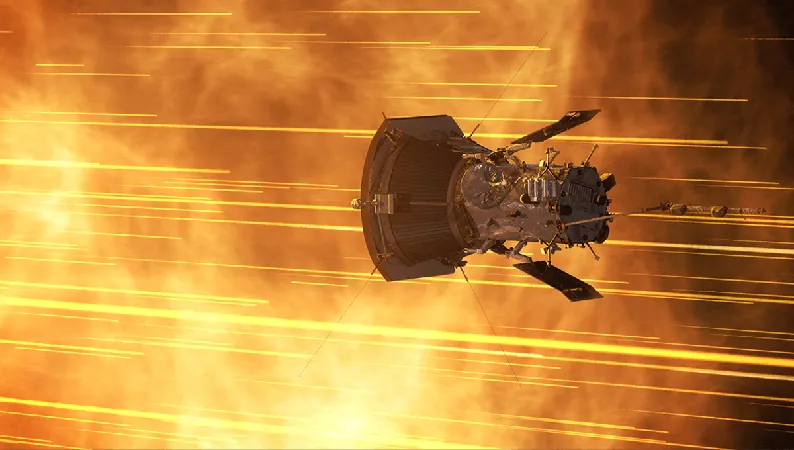
Unraveling the Mystery: Did the Oceanic Crust Sink, Causing a 30-Meter Drop in Sea Levels?
2025-05-21
Author: Lok
A Remarkable Geological Tale
Prepare to be astonished by the tales our planet tells! A significant geological event, which unfolded between 15 and 6 million years ago, has recently come back into focus. Researchers now propose that a dramatic modification of the oceanic crust could have led to a staggering sea level drop of around 30 meters, completely transforming coastlines and marine ecosystems across the globe.
Tectonic Forces at Play
While today’s rising sea levels are predominantly driven by climate change, the epic saga of Earth’s history reveals an entirely different narrative. A groundbreaking study published in early 2025 by Colleen A. Dalton and her research team sheds light on how tectonic processes significantly shaped our oceans. Their findings highlight a 35% reduction in oceanic crust production during a pivotal timeframe that lasted millions of years.
This slowdown in seafloor spreading had an enormous impact. As the formation of new rock at oceanic ridges dwindled, ocean basins became deeper. The research indicates that this tectonic lag caused sea levels to plummet between 26 to 32 meters—an extraordinary indication of Earth’s dynamic systems at work.
Impacts on Marine Life and Ecosystems
Significant fluctuations in sea levels do more than just reconfigure coastlines; they also exert evolutionary pressures on marine life. Just as we uncover fascinating creatures in the ocean depths today, the historical shifts likely spurred new adaptations in ancient marine organisms, thereby shaping the diversity we see now.
Thermal Changes and Global Cooling
The study also uncovered thermal ramifications linked to the tectonic slowdown. Heat dissipation through the oceanic crust diminished by about 8% during this period, particularly affecting oceanic ridges which experienced a more marked 35% decrease. These thermal alterations might have changed the chemistry of seawater by influencing hydrothermal interactions and mineral dissolution.
The Volcanic Connection and Climate Crisis
The production of oceanic crust relies heavily on underwater volcanic activity that contributes carbon dioxide to our atmosphere. The diminished crust formation appeared to have curbed CO₂ emissions, resulting in global cooling. This further increased ice sheet expansion, sequestering more water and leading to significant reductions in ocean volume.
A Feedback Loop of Climate Change
According to researchers, this interplay of oceanic thermal contraction and burgeoning ice sheets might have further driven sea levels down by an additional 60 meters. Such astounding geological shifts also coincided with dramatic formations elsewhere in our solar system, underscoring the ever-evolving story of planetary action.
Unearthing Geological Evidence
While concrete evidence of ancient sea levels is scarce, the study’s conclusions resonate with coastal sedimentary data from places like New Jersey and offshore Nova Scotia. These records strongly support the idea of significant oceanic regression during that era.
Insights for Today's Climate Challenges
Understanding these past sea level changes grants us insight into modern climate research. Just as we track giant creatures in oceans today, geologists analyze sediment layers to unearth Earth’s varied environmental history. These geological insights reveal the intricate connections within Earth's ecosystems over vast timescales.
The oceanic crust analysis by Dalton and her team proves that sea level changes are influenced by various factors, including tectonic shifts and climatic conditions. Such research deepens our understanding of how cosmic influences sculpt our planet. As contemporary challenges regarding sea levels grow more pressing, it's critical to remember that Earth’s oceans have always been in motion—though today’s rapid changes are driven more by human activities than by the slow tectonic shifts of yore.





 Brasil (PT)
Brasil (PT)
 Canada (EN)
Canada (EN)
 Chile (ES)
Chile (ES)
 Česko (CS)
Česko (CS)
 대한민국 (KO)
대한민국 (KO)
 España (ES)
España (ES)
 France (FR)
France (FR)
 Hong Kong (EN)
Hong Kong (EN)
 Italia (IT)
Italia (IT)
 日本 (JA)
日本 (JA)
 Magyarország (HU)
Magyarország (HU)
 Norge (NO)
Norge (NO)
 Polska (PL)
Polska (PL)
 Schweiz (DE)
Schweiz (DE)
 Singapore (EN)
Singapore (EN)
 Sverige (SV)
Sverige (SV)
 Suomi (FI)
Suomi (FI)
 Türkiye (TR)
Türkiye (TR)
 الإمارات العربية المتحدة (AR)
الإمارات العربية المتحدة (AR)